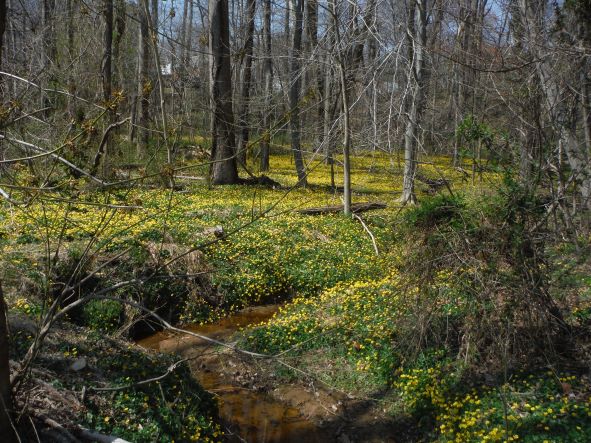I post here photos from two creek valleys in northern Virginia.
The Accotink creek valley is completely overrun by invasive plants … the herbaceous layer is made up of lesser celandine (Ficaria verna Huds; Ranunculus ficaria L.) and – in some places — Leucojum.

Neighboring Pohick creek valley still supports native hebaceous plants – skunk cabbage, spring beauties, trout lillies.

They both flow through wealthier suburbs in Fairfax County.

?????
P.S. In a ditch connecting to Pohick creek I have found this aquatic plant:

Plant is rooted, but leaves float on the water surface. In March the leaves were wide with scalloped edges; by April they are longer – lanceolate? I have seen it nowhere else. Anyone know what it is? Local authorities say it is not water chestnut (Trapa).
Posted by Faith Campbell
We welcome comments that supplement or correct factual information, suggest new approaches, or promote thoughtful consideration. We post comments that disagree with us — but not those we judge to be not civil or inflammatory.
For a detailed discussion of the policies and practices that have allowed these pests to enter and spread – and that do not promote effective restoration strategies – review the Fading Forests report at http://treeimprovement.utk.edu/FadingForests.htm

Here you are entering the Bermuda Triangle of plant ecology: Asking why a plant grows here and not there. Many a good grad student has disappeared into questions like this.
The problem is that the answer is almost always some combination of soil, climate, history, and the vagaries of where a seed happens to land. For invasives, it is also the fact that we are usually witnessing a snapshot in time from a process that is unfolding on a longer time scale.
If you can see the pattern on a broader scale—i.e., a certain type of valley always has this plant, while other valleys do not—you have a hope of an answer. That means the cause is probably edaphic or climatic.
One typical response of plant ecologists in this situation would be to do a transplant experiment. Transplant the plants from Accotink to Pohick and vice versa, in experimental plots, and then see what happens. Of course with invasives, this is probably unethical. The other response would be to take soil samples and look for some big differences in pH, moisture, calcium, nitrogen, or some other important nutrient. That gives clues but no firm answers.
Good luck!